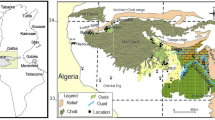Abstract
During the “water cycle” process, inorganic as well as organic substances are dissolved, which is completely normal. Organic substances can originate from decaying tree leaves that fall into rivers and lakes, from sewage from living organisms that live in water (e.g. fish) and human waste. Inorganic substances can come from lead and copper in water pipes, from pesticides and generally from various human activities. All these elements contribute to increase of water conductivity. The higher the conductivity in water, the more dangerous it becomes for humans [4]. The purpose of this research is to evaluate and classify water conductivity levels at the “Bramianon” dam of Crete, with the development of powerful Machine Learning models capable of successfully assigning three labels “Low”, “Medium”, “High”.
Access this chapter
Tax calculation will be finalised at checkout
Purchases are for personal use only
Similar content being viewed by others
References
Georgouli, A.: Machine Learning (chapter 4). Artificial Intelligence. Kallipos (open academic publishing) (2015). https://repository.kallipos.gr/handle/11419/3382
Iliadis, L.: Artificial Intelligence & Intelligent Agents. Tziola (2017)
Kulkarni, A.: Foundations of data imbalance and solutions for a data democracy (2020)
Margiolos, G.: Filtranerou (2018). https://www.filtra.nerou.gr/ti-einai-i-agogimotita-kai-pos-na-ti-metriso/
Modern Analytics (2022). https://modernanalytics.gr/water-quality/
Republic, G.: Decentralized Administration of Crete (2022). https://www.apdkritis.gov.gr/el
Wikiloc: wikiloc.com (2022). https://el.wikiloc.com/oreibasiadiadromes/tekhnete-limne-mpramianon-kuklike-93360110#comments
Valanti, Eleni A.: Analysis of ROC curves and their application to real biomedical data (2011). https://doi.org/10.26240/heal.ntua.246
Tarun A.: Advanced Ensemble Classifiers (2019). https://towardsdatascience.com/advanced-ensemble-classifiers8d7372e74e40
Radhakrishnan, N., Pillai, A.S.: Comparison of water quality classification models using machine learning (2020). https://ieeexplore.ieee.org/abstract/document/9137903/authors#authors
Sharma, P., Ramesh, K., Parameshwaran, R., Deshmukh, S.S.: Thermal conductivity prediction of titania-water nanofluid: a case study using different machine learning algorithms (2022). https://www.sciencedirect.com/science/article/pii/S2214157X21008212
Araya, S.N., Ghezzehei, T.A.: Using machine learning for prediction of saturated hydraulic conductivity and its sensitivity to soil structural perturbations (2019). https://doi.org/10.1029/2018WR024357
Lu, H., Ma, X.: Hybrid decision tree-based machine learning models for short-term water quality prediction (2020). https://www.sciencedirect.com/science/article/abs/pii/S0045653520303623?casatoken=i6XAYel24IkAAAAA:C4MoJJXCEQKif2Egqa2IZSydMixWpVzMbZGzSPWa7Pion2NF4oW7NF%20Cuxe%20C8rw%20ZYMz4%20S4Q
Katsantonis, A.: Data analysis and categorization (2020). https://dione.lib. upi.gr/xmlui/bitstream/handle/unipi/12983/Katsantonis_1608.pdf?sequence=1&isAllowed=y
Filotheou. A.X.: Multi-category Sorting with Brainstorming Classifier Systems (2013). http://ikee.lib.auth.gr/record/291560/files/philotheou-Thesis-AUTh-2013.pdf
Hydrological Data of “Bramianon Dam” Hydrological Station (2022). https://data.apdkritis.gov.gr/el/dataset/%CF%85%CE%B4%CF%81%CE%BF%CE%BB%CE%BF%CE%B3%CE%B9%CE%BA%CE%AC%CE%B4%CE%B5%CE%B4%CE%BF%CE%BC%CE%AD%CE%BD%CE%B1%CF%85%CE%B4%CF%81%CE%BF%CE%BB%CE%BF%CE%B3%CE%B9%CE%BA%CE%BF%CF%8D%CF%83%CF%84%CE%B1%CE%B8%CE%BC%CE%BF%CF%8D%CF%86%CF%81%CE%AC%CE%B3%CE%BC%CE%B1%CE%BC%CF%80%CF%81%CE%B1%CE%BC%CE%B9%CE%B1%CE%BD%CF%8E%CE%BD
Brown, B.: Machine learning, explained (2021). https://mitsloan.mit.edu/ideas-made-to-matter/machine-learning-explained
Feature scaling (2022). https://en.wikipedia.org/wiki/feature_scaling#cite_note-2
Gupta, S.: Machine Learning Concepts (2021). https://ml-concepts.com/2021/10/08/min-max-normalization/
Dritsas, E., Trigka, M.: Efficient Data-Driven Machine Learning Models for Water Quality Prediction (2023). https://doi.org/10.3390/computation11020016
Hamza, A.M., et al.: Water-Quality Prediction Based on H2O AutoML and Explainable AI Techniques (2023). https://www.mdpi.com/2073-4441/15/3/475
Author information
Authors and Affiliations
Corresponding author
Editor information
Editors and Affiliations
Rights and permissions
Copyright information
© 2023 The Author(s), under exclusive license to Springer Nature Switzerland AG
About this paper
Cite this paper
Nichat, K., Iliadis, L., Papaleonidas, A. (2023). Conductivity Classification Using Machine Learning Algorithms in the “Bramianon” Dam. In: Iliadis, L., Maglogiannis, I., Alonso, S., Jayne, C., Pimenidis, E. (eds) Engineering Applications of Neural Networks. EANN 2023. Communications in Computer and Information Science, vol 1826. Springer, Cham. https://doi.org/10.1007/978-3-031-34204-2_9
Download citation
DOI: https://doi.org/10.1007/978-3-031-34204-2_9
Published:
Publisher Name: Springer, Cham
Print ISBN: 978-3-031-34203-5
Online ISBN: 978-3-031-34204-2
eBook Packages: Computer ScienceComputer Science (R0)




